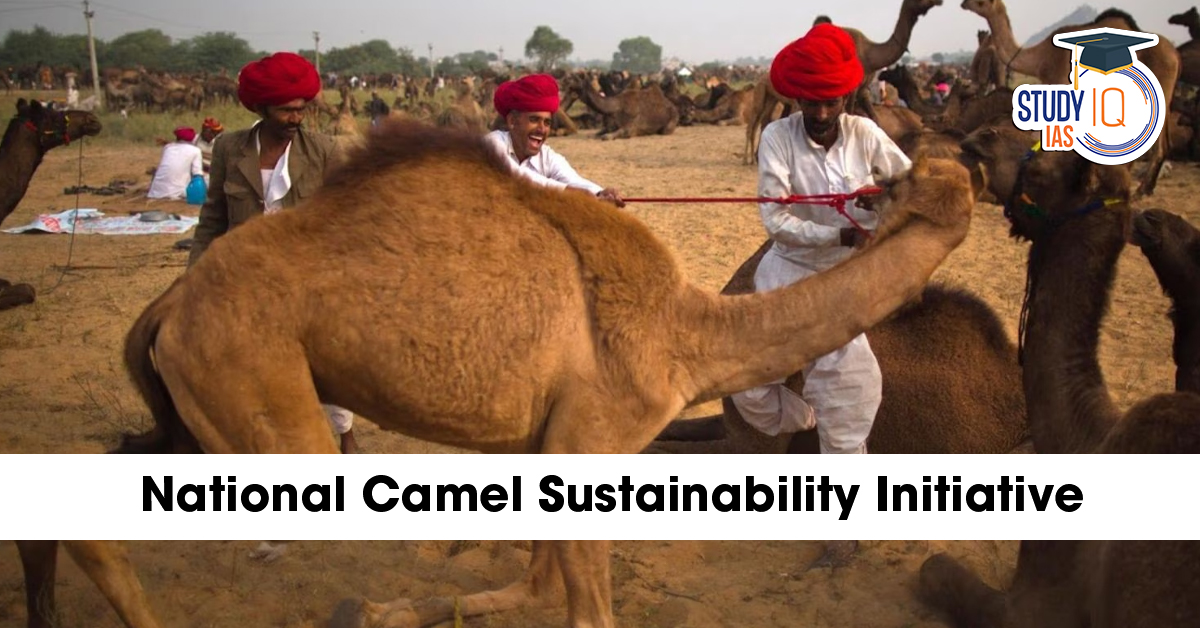Table of Contents
Once known as the “Ship of the Desert,” the camel has long been a symbol of resilience and sustenance in India’s arid and semi-arid landscapes. However, over the past few decades, India’s camel population has witnessed a dramatic decline — nearly 75% since 1977. This alarming trend has raised concerns about the future of desert ecosystems and the livelihoods of pastoral communities.
To address this, the Central Government is preparing to launch the National Camel Sustainability Initiative (NCSI) — a comprehensive mission that brings together multiple ministries, state governments, and international partners like the FAO to reverse this decline and ensure sustainable camel conservation.
About the National Camel Sustainability Initiative (NCSI)
The National Camel Sustainability Initiative (NCSI) is a multi-ministerial mission aimed at protecting and promoting the ecological, economic, and cultural significance of camels in India.
Participating Ministries and Departments:
-
Department of Animal Husbandry and Dairying (Nodal body)
-
Ministry of Environment, Forest and Climate Change
-
Ministry of Rural Development
-
Ministry of Tourism
-
State Governments — especially Rajasthan and Gujarat
-
Developed in consultation with the Food and Agriculture Organization (FAO)
Key Objectives of NCSI
-
Reverse the decline of India’s camel population.
-
Strengthen breeding programs and genetic conservation.
-
Prevent cross-border smuggling and illegal slaughter.
-
-
Restore the ecological role of camels.
-
Recognize camels as an essential component of arid-zone biodiversity.
-
Promote sustainable grazing and the restoration of desert ecosystems.
-
-
Support pastoral livelihoods.
-
Provide income support to Raika and Rabari pastoral communities.
-
Develop camel-based industries such as milk, wool, and eco-tourism.
-
-
Promote conservation and regulated trade.
-
Frame policies for sustainable camel husbandry and trade.
-
Encourage camel fairs and cultural festivals under tourism schemes.
-
Background: Declining Camel Population in India
India’s camel population has been declining sharply for decades.
| Year | Camel Population (in lakh) |
|---|---|
| 1977 | 11.0 |
| 2013 | 4.0 |
| 2019 (20th Livestock Census)** | 2.52 |
-
Nearly 90% of India’s camels are concentrated in Rajasthan and Gujarat.
-
Once used for transportation, milk, and agriculture, camels now struggle for survival due to modernization, mechanization, and loss of grazing lands.
Ecological and Cultural Importance of Camels
-
Ecological Role:
-
Camels are crucial for maintaining the fragile desert ecosystem.
-
They help in seed dispersal, manure enrichment, and sustainable grazing.
-
-
Economic Importance:
-
Camel milk, leather, and wool industries provide livelihoods to rural artisans.
-
The camel milk market is expanding due to its nutritional and medicinal properties.
-
-
Cultural Heritage:
-
Camels have deep ties to Rajasthani identity — symbolized in the Pushkar Camel Fair and the Desert Festival of Jaisalmer.
-
They represent traditional knowledge systems and pastoral harmony with nature.
-
Challenges to Camel Conservation
-
Shrinking grazing lands and desertification.
-
Decline in demand for camel transport due to mechanization.
-
Limited veterinary care and breeding programs.
-
Ban on camel trade across states, reducing pastoral income.
-
Lack of awareness about camel-based products and tourism.
Government’s Multi-Dimensional Approach
The National Camel Sustainability Initiative (NCSI) will take a holistic approach to revive camel-based ecosystems:
| Focus Area | Proposed Actions |
|---|---|
| Conservation & Breeding | Establish Camel Conservation Centers and breeding farms. |
| Veterinary Support | Improve camel healthcare infrastructure and mobile vet units. |
| Economic Incentives | Encourage camel milk cooperatives and desert tourism models. |
| Research & Training | Promote scientific research on camel health, nutrition, and genetics. |
| Public Awareness | Organize camel festivals, exhibitions, and educational programs. |
Linking Camel Conservation to Sustainable Development
The NCSI aligns with several UN Sustainable Development Goals (SDGs):
-
SDG 1: No Poverty – Supporting pastoral livelihoods.
-
SDG 12: Responsible Consumption and Production – Promoting sustainable camel products.
-
SDG 15: Life on Land – Conserving desert ecosystems and biodiversity.
By integrating camel conservation with climate resilience and rural development, the initiative embodies India’s commitment to inclusive and sustainable growth.
Significance of the Initiative
-
Revives India’s cultural identity linked to desert heritage.
-
Restores ecological balance in fragile arid ecosystems.
-
Provides economic empowerment to pastoral communities.
-
Enhances tourism potential in Rajasthan, Gujarat, and desert regions.
-
Strengthens India’s animal husbandry and biodiversity conservation efforts.
Conclusion
The National Camel Sustainability Initiative (NCSI) marks a crucial step in preserving India’s desert legacy. By combining conservation with livelihood generation, it seeks to ensure that camels — once the lifeline of desert civilizations — continue to thrive as symbols of resilience, sustainability, and cultural pride.
India’s success in this mission will not only safeguard a species but also reaffirm the nation’s commitment to environmental stewardship and traditional wisdom.


 Rare Hawfinch Sighting in Corbett Nation...
Rare Hawfinch Sighting in Corbett Nation...
 Bnei Menashe Community : The Lost Tribe ...
Bnei Menashe Community : The Lost Tribe ...
 Animal Husbandry Statistics 2025: Global...
Animal Husbandry Statistics 2025: Global...

























